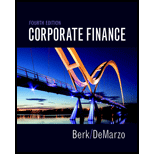
To discuss: The fund that is recommended by Person X (financial advisor) without knowing about the client’s risk.
Introduction:
Portfolio refers to a set of financial investments owned by an investor. The portfolio of investments includes debentures, stocks, bonds, and mutual funds.
The average return that is incurred in excess of the risk-free rate per unit of the volatility is termed as Sharpe ratio. Its measure indicates the amount of excess return that an investor incurs for an additional volatility, which the investor endures for holding a risky asset. The efficient portfolio is a particular portfolio with the maximum Sharpe ratio in an economy.
Want to see the full answer?
Check out a sample textbook solution
Chapter 11 Solutions
Corporate Finance Plus MyLab Finance with Pearson eText -- Access Card Package (4th Edition) (Berk, DeMarzo & Harford, The Corporate Finance Series)
- You just borrowed $203,584. You plan to repay this loan by making regular quarterly payments of X for 69 quarters and a special payment of $56,000 in 7 quarters. The interest rate on the loan is 1.94 percent per quarter and your first regular payment will be made today. What is X? Input instructions: Round your answer to the nearest dollar. 59arrow_forwardYou plan to retire in 4 years with $698,670. You plan to withdraw $X per year for 17 years. The expected return is 17.95 percent per year and the first regular withdrawal is expected in 5 years. What is X? Input instructions: Round your answer to the nearest dollar. $arrow_forwardYou just borrowed $111,682. You plan to repay this loan by making X regular annual payments of $15,500 and a special payment of $44,900 in 10 years. The interest rate on the loan is 13.33 percent per year and your first regular payment will be made in 1 year. What is X? Input instructions: Round your answer to at least 2 decimal places.arrow_forward
- You just borrowed $174,984. You plan to repay this loan by making regular annual payments of X for 12 years and a special payment of $11,400 in 12 years. The interest rate on the loan is 9.37 percent per year and your first regular payment will be made today. What is X? Input instructions: Round your answer to the nearest dollar. $arrow_forwardYou plan to retire in 7 years with $X. You plan to withdraw $54,100 per year for 15 years. The expected return is 13.19 percent per year and the first regular withdrawal is expected in 7 years. What is X? Input instructions: Round your answer to the nearest dollar. 59 $arrow_forwardYou plan to retire in 3 years with $911,880. You plan to withdraw $X per year for 18 years. The expected return is 18.56 percent per year and the first regular withdrawal is expected in 3 years. What is X? Input instructions: Round your answer to the nearest dollar. 99 $arrow_forward
- You have an investment worth $56,618 that is expected to make regular monthly payments of $1,579 for 25 months and a special payment of $X in 8 months. The expected return for the investment is 0.76 percent per month and the first regular payment will be made today What is X? Note: X is a positive number. Input instructions: Round your answer to the nearest dollar. $arrow_forwardYou plan to retire in 8 years with $X. You plan to withdraw $114,200 per year for 21 years. The expected return is 17.92 percent per year and the first regular withdrawal is expected in 9 years. What is X? Input instructions: Round your answer to the nearest dollar. $ EAarrow_forwardYou have an investment worth $38,658 that is expected to make regular monthly payments of $1,130 for 16 months and a special payment of $X in 11 months. The expected return for the investment is 1.46 percent per month and the first regular payment will be made in 1 month. What is X? Note: X is a positive number. Input instructions: Round your answer to the nearest dollar. $arrow_forward
- You just borrowed $373,641. You plan to repay this loan by making regular annual payments of X for 18 years and a special payment of $56,400 in 18 years. The interest rate on the loan is 12.90 percent per year and your first regular payment will be made in 1 year. What is X? Input instructions: Round your answer to the nearest dollar. EA $arrow_forwardHow much do you need in your account today if you expect to make quarterly withdrawals of $6,300 for 7 years and also make a special withdrawal of $25,700 in 7 years. The expected return for the account is 4.56 percent per quarter and the first regular withdrawal will be made today. Input instructions: Round your answer to the nearest dollar. $ 69arrow_forwardYou just bought a new car for $X. To pay for it, you took out a loan that requires regular monthly payments of $2,200 for 10 months and a special payment of $24,100 in 6 months. The interest rate on the loan is 1.07 percent per month and the first regular payment will be made today. What is X? Input instructions: Round your answer to the nearest dollar. 59 $arrow_forward
 Pfin (with Mindtap, 1 Term Printed Access Card) (...FinanceISBN:9780357033609Author:Randall Billingsley, Lawrence J. Gitman, Michael D. JoehnkPublisher:Cengage Learning
Pfin (with Mindtap, 1 Term Printed Access Card) (...FinanceISBN:9780357033609Author:Randall Billingsley, Lawrence J. Gitman, Michael D. JoehnkPublisher:Cengage Learning
